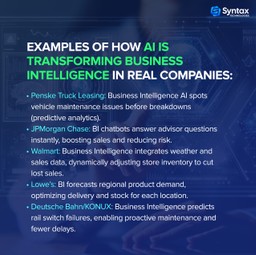If you’re looking at the data/analytics space right now, it’s hard to ignore the buzz around AI. Tools are getting smarter, dashboards are building themselves, and natural language queries mean you don’t even have to know SQL to pull insights. So the obvious question is: what happens to Business Intelligence (BI) analysts in all this?
AI is definitely shaking up BI roles, but it’s not about replacing you with robots. It’s more about your tools changing—so you either adapt or risk falling behind.

How AI is Changing BI
- Automated Data Prep & Reporting
Traditionally, BI analysts spent hours cleaning data, creating joins, or building routine dashboards. AI-powered ETL tools and self-service platforms (like Power BI with Copilot or Tableau GPT) now automate a lot of that grunt work.
- Natural Language Querying
You don’t need to know SQL anymore to pull data. Platforms like ThoughtSpot let business users type “What were sales last quarter in Europe?” and get instant charts. This shifts part of the responsibility away from BI analysts to end-users. - Predictive & Prescriptive Analytics
BI used to be mostly descriptive—“What happened?” Now, AI models are built right into BI tools to answer “What will happen?” and “What should we do?” That means BI roles are moving closer to data science territory. - Real-Time Decisioning
With AI and ML, companies aren’t just looking at last month’s numbers—they’re making decisions on live data streams. That requires BI professionals to understand how to work with real-time pipelines.
Does This Mean Fewer BI Jobs?
Not really—at least not if you evolve with the tools. Gartner actually predicted that by 2025, over 80% of BI tasks will be handled by AI and automation. But here’s the good part: demand for data-literate professionals is still growing.
According to the U.S. Bureau of Labor Statistics, jobs in data-related fields are projected to grow much faster than average this decade.
What’s happening is a shift in focus:
- Less time on manual reporting
- More time on strategy, storytelling, and translating insights into business action
In other words, the BI analyst who only builds static dashboards may feel squeezed. But the BI analyst who can frame the right questions, validate AI-driven outputs, and explain insights to decision-makers? They’re becoming even more valuable.
The Skills BI Analysts Now Need
If you’re in BI today (or looking to get in), here’s what helps future-proof your role:
- Understanding AI/ML basics (you don’t need to go as deep as a data scientist—just know what’s realistic and what isn’t).
- Business acumen—knowing why the numbers matter.
- Data storytelling—turning charts into actionable narratives.
- Tool fluency—Power BI, Tableau, Looker, and their AI add-ons.
- Collaboration—working with data engineers and data scientists, not in silos.
So, Is AI a Threat or an Opportunity?
AI is disrupting BI by taking away repetitive tasks and democratizing access to insights. But that also frees up BI analysts to do higher-value work: shaping strategy, asking smarter questions, and being the bridge between raw data and business impact.
AI won’t kill BI—but it will kill the old-school version of BI that’s stuck in just building static dashboards.
Conclusion
AI is no doubt transforming the way Business Intelligence roles look and function. The repetitive parts of the job—data cleaning, basic reporting, dashboard building—are increasingly being automated. But that doesn’t make BI professionals irrelevant. Instead, it shifts the role toward areas where humans excel: asking the right questions, validating AI-driven insights, and connecting data to real business outcomes.
If you’re in BI today, the real risk isn’t AI itself—it’s staying static while the field evolves around you. The professionals who stay curious, pick up new tools, and focus on strategy and storytelling will not only remain relevant but become even more indispensable in the AI-driven future of analytics.

